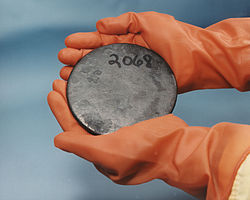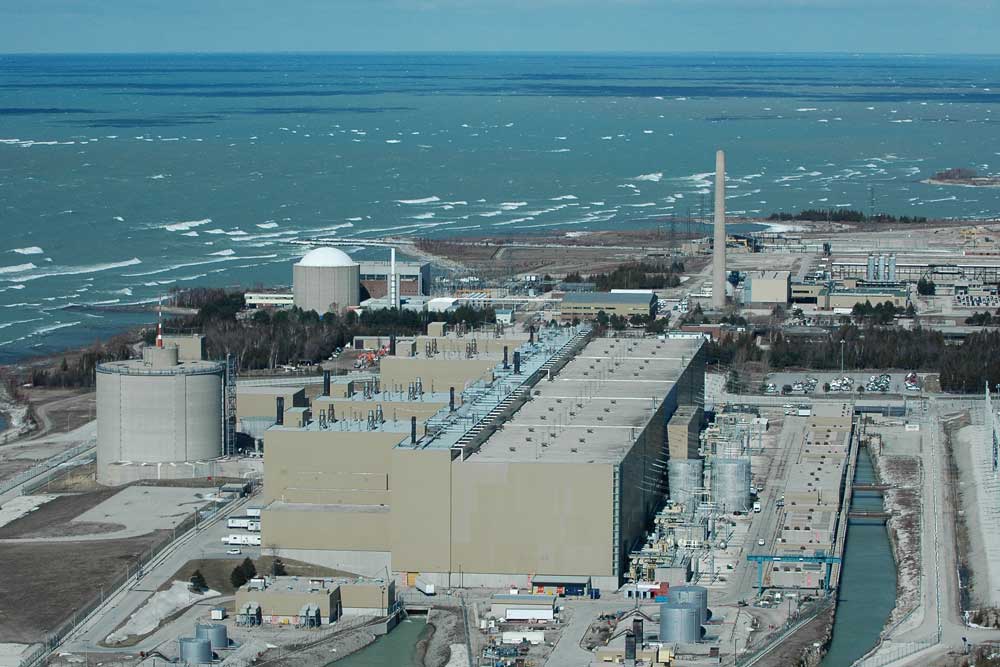Nuclear Power
By the Numbers
443
Operational nuclear power plants around the world in 2011
31
Countries operating nuclear power plants in 2011
$5 to 12 billion
Cost to build a new nuclear power plant in the United States
1 death
From nuclear power for every 4,000 deaths from coal power
3 g
CO2 released by nuclear power per kWh of electricity, less than wind, solar and hydroelectric
10,000 years
How long an underground repository must be able to safely store nuclear waste
Last Updated: February 2017
Nuclear power plays an important role in electricity generation across the world, and over 443 nuclear power plants are in operation. In Canada, nuclear is important in Ontario's industrial heartland and supplies over half the province's electricity. There are currently no nuclear power plants in Western Canada: The B.C. government has prohibited power nuclear plants and uranium mining. Over the border, Alberta's government is considering proposals to use nuclear energy to help extract oil from the tar sands.
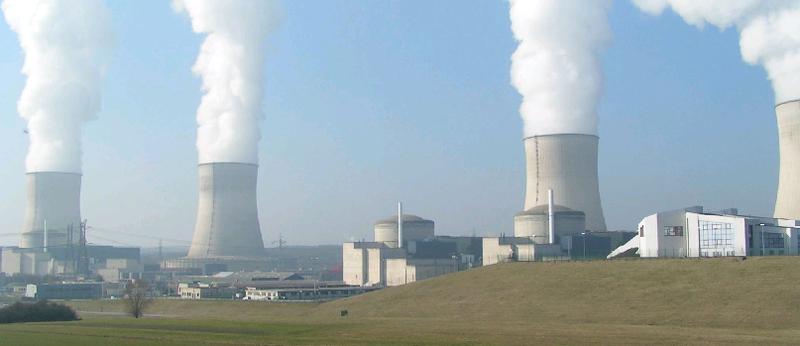
The basic workings of nuclear power are fairly straightforward: A nuclear reactor produces energy by nuclear
Although in the early days of its development during the 1960s and 1970s, nuclear power plants were built rapidly, public attitudes to it have cooled. Since the Chernobyl nuclear meltdown in 1986, few new nuclear power plants have been built and there has been staunch opposition to any new plant proposals. The situation is not static though. Instability in fossil fuel prices and concerns about global warming have driven a renewal of interest in nuclear power among policy-makers and investors. Nuclear power is a viable fossil fuel alternative because a nuclear reactor emits no carbon and nuclear power is as carbon friendly as wind or geothermal power. However poor economic conditions, low public support and most recently the crisis at the Fukushima plant in Japan have made any resurgence of nuclear power difficult to realize. The German government, in direct response to the Fukushima accidents, has announced it will close all their nuclear plants by 2022. German Chancellor Merkel believes her country can replace the 23% of power that nuclear power already provides in Germany by up-scaling renewables such as wind and solar. Many analysts suspect in reality Germany will just have to import nuclear-derived electricity from France.
Though negative public perceptions about nuclear safety are not entirely deserved, the nuclear industry can never offer a complete guarantee against another nuclear accident. Nor has it satisfactorily dealt with the radioactive waste that nuclear power plants produce. There are also limitations on the amount of minable radioactive ores, and geopolitical issues associated with this as well. These challenges must be properly addressed in the near future if nuclear power is to continue to play an important role in the global economy, though technological developments in nuclear power plants over the next 20 years can reasonably be expected to solve many of these problems. Even more exciting, scientists are continuing development on plants that can harness the nuclear process that fuels stars, fusion. The holy grail of energy research, it is thought fusion may be able to provide unlimited, safe and clean energy--virtually forever. All this means that at present nuclear power's role in the 21st Century remains uncertain.
- World Nuclear Association. 'World Nuclear Power Reactors & Uranium Requirements.' Last modified April 1, 2011. http://www.world-nuclear.org/info/reactors.html
- Ontario Power Generation. 'Nuclear Power in Ontario.' Retrieved July 26, 2011. http://www.opg.com/power/nuclear/
- Documents of the B.C. Legislature. 'Bill 17 – 2010: Clean Energy Act. Part 1, Section 2.' Accessed May 12, 2011. http://www.leg.bc.ca/39th2nd/1st_read/gov17-1.htm#section2
- Government of Alberta: Energy. 'Nuclear Power.' Retrieved July 26, 2011. http://www.energy.alberta.ca/Electricity/1577.asp
- World Nuclear Association. Nuclear Renaissance. Retrieved August 23, 2011. http://www.world-nuclear.org/info/inf104.html
- Polson, J., Chipman, K & Chediak, M. Nuclear Renaissance Threatened as Japan's Reactor Struggles. Bloomberg News. March 13, 2011. Accessed August 15, 2011. http://www.bloomberg.com/news/2011-03-13/nuclear-renaissance-threatened-as-japan-fights-meltdown-at-quake-hit-plant.html
- Der Spiegel. 'Nuclear Phaseout Is an 'Historic Moment'' May 30, 2011, accessed July 25, 2011. http://www.spiegel.de/international/germany/0,1518,765681,00.htmll
- World Nuclear Association. 'Safety of Nuclear Reactors.' Last modified 26 July 2011. Accessed 28 July 2011, http://www.world-nuclear.org/info/inf06.html
- Gnansounou, E. and Bedniaguine, D. Potential Role of Fusion Power Generation in a Very Long Term Electricity Supply Perspective: Case of Western Europe. Swiss Federal Institute of Technology. Accessed July 24, 2011. http://www-pub.iaea.org/mtcd/publications/pdf/p1250-cd/papers/sese-v.pdf
How Nuclear Power Works
Mining and Refining Nuclear Fuel
Nuclear power begins with the mining of a reactor's fuel: uranium. Uranium is a naturally occurring and relatively commonplace metal—there is about as much of it around the world as tin. Uranium will occur in ores with a grade that can be as high as 20% in some cases, though it can be economical to mine ores with grades as low as 0.02%.
Once uranium is extracted from the ground, either from an underground or a surface mine, it must go through a complicated refining process. Most mines use on-site crushers to grind up the ore and use a combination of sulfuric acid, settling tanks, and ion exchangers to separate uranium from rock tailings. The result is a precipitate of uranium, which, when dried, becomes a uranium oxide (U3O8). This uranium is not enriched and only mildly radioactive. It is known as yellowcake.
At this stage, most nuclear reactors in the world require that the mined uranium must be enriched, so that the fissionable U-235 isotopes go from their naturally occurring 0.7% to around 20%.
Before enrichment can take place, the yellowcake must be converted into a gas: uranium hexafluoride. Now the uranium is ready for enrichment. Enrichment involves using rapidly-spinning centrifuges which can separate out the heavier uranium-235 atoms.
Enrichment is expensive, adding up to about half the total cost of nuclear fuel. Once uranium has been enriched it is ready to undergo nuclear fission.
How a Nuclear Reactor Works
Nuclear fission is the splitting of unstable atoms, typically uranium, though some power plants use plutonium. Though most uranium is U-238 and is not fissile, about 0.72% of uranium atoms are unstable U-235. If an atom of U-235 collides with a neutron it will split into two new atoms, releasing a large amount of energy and two neutrons. This process occurs naturally, giving off radiation, but when it is sped up by enriching natural uranium to contain a higher proportion of U-235, in the right conditions it can become a self-sustaining chain reaction that releases tremendous amounts of thermal energy.
How is this heat harnessed by a nuclear reactor? The example we will use is a Boiling Water Reactor (BWR), the second most common type of reactor in the world and the primary reactor used in the United States, Japan and many European countries. For more information on the other reactor types, and Canada's own reactor design the CANDU, we will soon be adding a new supplementary article. Usually uranium is enriched with U-235 to form around 20% of the nuclear fuel. This uranium fuel is manufactured into small pellets that are themselves arranged into bundles of fuel rods. Typically the fuel rods will be submerged in water inside the reactor core. This serves three purposes.
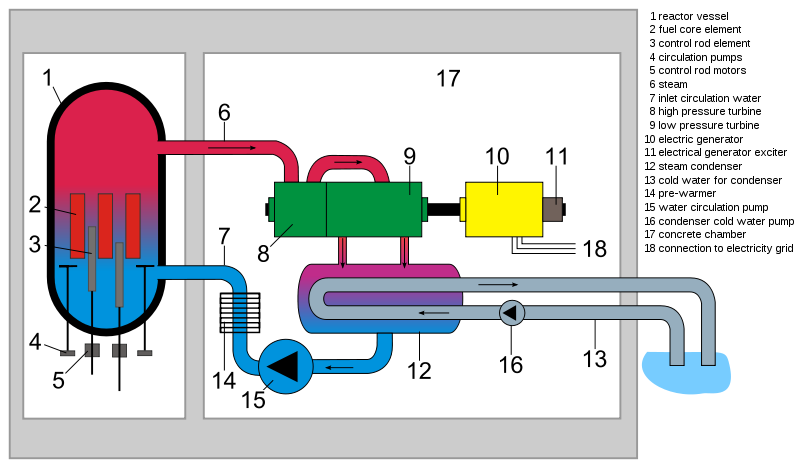
First the water can act as a moderator. A uranium atom needs to be struck by a neutron in order for nuclear fission to occur, but most of the time neutrons are moving too fast to react with a uranium atom. Water slows down neutrons, moderating their speed. The neutrons pass through the water between the fuel bundles, are slowed down, and able to react with other U-235 atoms.
Secondly, the water is a coolant. It is imperative that the reactor stay submerged in water to help cool the fuel bundles, otherwise they would overheat and melt. This is a nuclear meltdown, and can lead to the uranium fuel burning through the floor of the reactor and exposing dangerous radiation to the outside environment. Reactors have a number of safety precautions to prevent meltdowns from happening, but meltdowns have occurred several times in the fifty years of civilian nuclear power use. It was once thought that the nuclear fuel, if left uncooled, would get so hot it would continue melting into the ground and pass through the entire earth, reaching China, hence the name China Syndrome. This is of course absurd, but exposed nuclear fuel rods do pose a grave risk to those around them. .
Thirdly the water is boiled off, and the steam is used to spin a turbine. That turbine is connected to a generator which generates electricity.
- World Nuclear Association. 'Uranium Mining.' Accessed August 24, 2011. http://www.world-nuclear.org/education/mining.htm
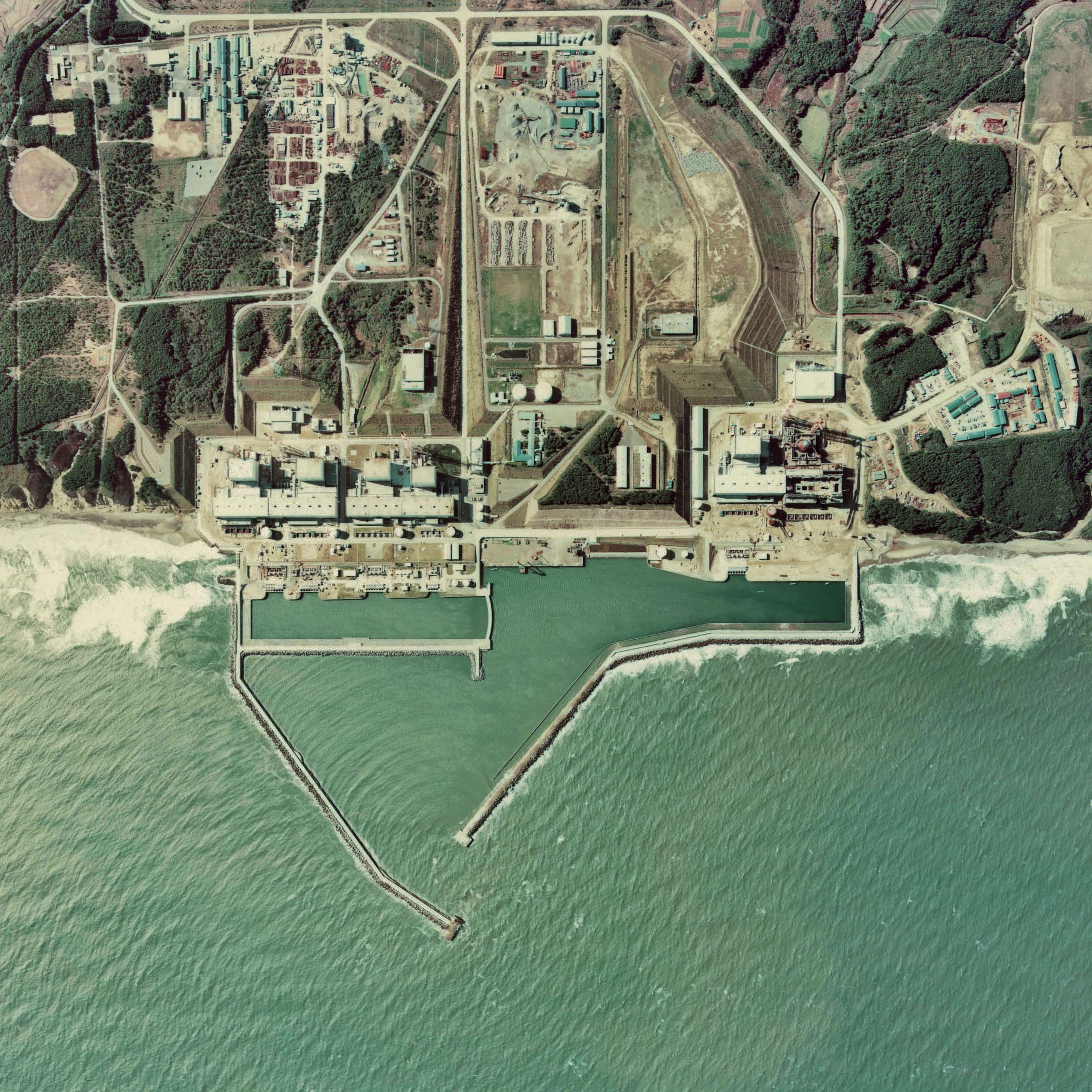
Geography of Nuclear Power
Nuclear power plants can be built essentially anywhere they can access the large amounts of water needed for cooling, anywhere from 95,000 to 227,000 litres per MWh of power generated. This could be from a river, a lake, or along the coastline. Logically, this would make British Columbia well-suited for nuclear power, but hydroelectric power currently satisfies the province's base-line electricity needs.
One geographical issue that has come into sharp focus in the aftermath of the Japanese earthquake and tsunami are the threat that natural disasters pose to nuclear facilities. The Fukushima 1 nuclear accidents in March 2011 resulted from the cascading failures of a number of fail-safes intended to prevent nuclear meltdown. Many nuclear reactors are built in earthquake-prone areas, especially in Japan, and many are built at the water's edge. Though Japan's plants have operated without serious accidents since the 1960s, they can be uniquely vulnerable to the one-two punch of an earthquake and tsunami. Over a dozen countries including China, Switzerland and Finland are reviewing their safety precautions in light of these events. Germany has already announced it will close all of its nuclear power plants by 2022 as a direct result of the events at Fukushima, though the geographical conditions that led to the Fukushima disaster do not exist in Germany.
- Glennon and Reeves 2010.
- Chandler, Jo. 'Is This the end of the nuclear revival?' Sydney Morning Herald, March 19, 2011. Accessed July 26, 2011. http://www.smh.com.au/environment/energy-smart/is-this-the-end-of-the-nuclear-revival-20110318-1c0i9.html
Economics of Nuclear Power
Is nuclear power economical? The answer depends largely upon the market conditions. As a general rule, nuclear power plants are more expensive to build and decommission than other power plants, but less expensive to operate.
An Inexpensive Fuel
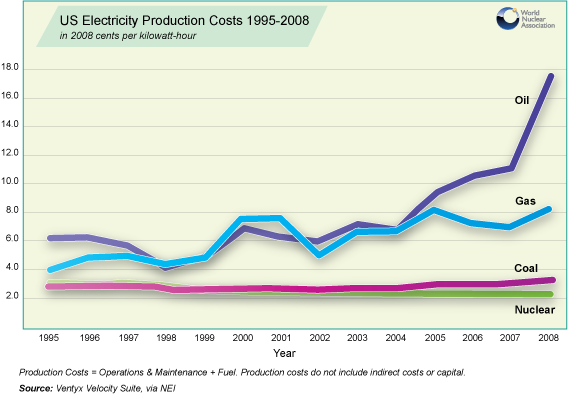
For its weight, uranium is comparatively expensive. To mine the uranium ore, convert it, enrich it and fabricate a kilogram of reactor fuel costs about $2,500. Although that might sound expensive, a kilogram of enriched processed uranium can be used to generate more energy than any other substance yet harnessed by mankind—about 360,000 kWh per kilogram, 20,000 times more energy than a kilogram of coal. Taking the fuel alone, the price of nuclear power is about 0.77 cents per kilowatt hour. Including operating and maintenance costs, this rises to just over 2 cents per kilowatt hour, which is far cheaper than any fossil fuel form of power, as evidenced by this graph.
In comparison with coal, nuclear fuel is more compact, the mining operations are not as vast and intensive (and potentially less environment disruptive), the ore is easier to transport, and since the fuel is only a small part of the cost of providing nuclear power, it's not as vulnerable to major price fluctuations. This final advantage makes nuclear power attractive amid ongoing supply challenges and cost increases in fossil fuel markets. Spent uranium fuel can also be reprocessed and reused as fuel in certain types of reactors.
Just like any other finite resource however, uranium deposits are limited and will eventually be exhausted. However, at current consumption rates uranium reserves can be expected to last about 230 years. We can also reasonably expect that new extraction and enrichment technologies can extend this time considerably. A near-term shortfall may be looming as supplies of uranium from decommissioned Russian and American nuclear weapons, which accounted for 44% of all nuclear fuel used in 2007, are expected to be fully utilized by around 2015. This has given some incentive to exploration and mining companies to make up for the shortage.
Uranium deposits are also not located uniformly around the globe, which can lead to geopolitical tensions between countries that possess uranium, and those who do not. This is not currently a serious issue as there are deposits on almost every continent and no major economies have yet found themselves cut off from supplies of uranium. The OECD countries have friendly suppliers in Canada, Australia, Niger and Namibia, while Russia and Kazakhstan's production is relied upon by China, India and Russia.
The High Cost of Everything Else
The economic problems with nuclear power revolve around plant construction, technical expertise, waste and reprocessing, and legal hurdles that nuclear energy faces in many countries. For starters, nuclear power plant proposals in OECD countries must address local concerns in extensive consultation and regulatory processes that can dissuade potential investors and projects. Once construction begins, extensive safety measures, back-up equipment and special materials that ensure the highest levels of safety possible add considerably to capital costs. This also means a new plant can take up to a decade to license and build.
As the Wall Street Journal recently reported, several other problems are handicapping any proposed new nuclear plant construction:
A new generation of nuclear power plants is on the board in the U.S. But the projected cost is causing some sticker shock: $5 billion to $12 billion per plant, double to quadruple earlier rough estimates. Part of the cost escalation is bad luck. Plants are being proposed in a period of skyrocketing costs for commodities such as cement, steel and copper; amid a growing shortage of skilled labour; and against a backdrop of a shrunken supplier network for the industry.
To compare, a new 1,000 MW coal-fired power plant can be brought online for around $1 billion.
Historically nuclear power plants have been prone to cost overruns and delays. The Darlington nuclear power plant in Ontario is cited internationally as a example. Started in 1980, it was only completed 13 years later approximately 300% over budget at a final tally of $14.4 billion.
A changing utilities market is also complicating the expansion nuclear power. To make a nuclear power plant an attractive investment, there must be a guaranteed market to justify the massive up-front price-tag and long-term logistical effort. These conditions were satisfied in the 1970's and 1980's as government-owned utilities exercised monopolies. Today many jurisdictions are increasingly privatizing their power companies and opening up the private sector market to competition and investment. In this atmosphere, it is difficult to convince investors of the appeal of spending $10 billion for nuclear power plant project that will come online in a decade. This contrasts with a competitive coal-burning plant that can be built and put in operation in a fraction of the time.
Finally after the nuclear plant is constructed, large sums of money have to be set aside for safely dealing with nuclear waste and eventually decommissioning the plant after it runs through its life-span, usually around 30 years. In the United States the Nuclear Waste Fund, paid by electric utilities that use nuclear power, runs to nearly $750 million a year.
Though nuclear fuel is comparatively cheap (on a per kWh basis) and relatively abundant, the plant itself is time-consuming to build, unpopular with the public, and difficult to put an accurate price tag on.
- World Nuclear Association. 'Economics of Nuclear Power' Last modified March 9, 2011. http://www.world-nuclear.org/info/inf02.html
- Steve Fetter. 'How long will the world's uranium supplies last?' Scientific American. January 26, 2009. http://www.scientificamerican.com/article.cfm?id=how-long-will-global-uranium-deposits-last
- World Nuclear Association. 'Uranium Supply.' Accessed July 26, 2011. http://www.world-nuclear.org/info/inf75.html
- 'International Atomic Energy Association.' 50 Years of Nuclear Energy Factsheet, accessed May 19, 2011. http://www.iaea.org/About/Policy/GC/GC48/Documents/gc48inf-4_ftn3.pdf.
- 'Keith Johnson. 'It's the Economics, Stupid: Nuclear Power's Bogeyman.' Wall Street Journal. May 12, 2008.
- World Nuclear Association. 'Economics of Nuclear Power.' Last modified March 9, 2011. http://www.world-nuclear.org/info/inf02.html..
- Bob Stewart. 'Liberal energy plan includes costly nuclear future for price hike weary consumers.' Kenora Daily Miner and News. January 2011. http://kenoradailyminerandnews.com/ArticleDisplay.aspx?e=2872984
- Blue Ribbon Commision on America's Nuclear Future. 'Draft Report to the Secretary of Energy.' July 29, 2011. http://brc.gov/sites/default/files/documents/brc_draft_report_29jul2011.pdf
- World Nuclear Association. 'Economics of Nuclear Power.' Last modified March 9, 2011. http://www.world-nuclear.org/info/inf02.html..
Environmental Issues of Nuclear Power
The environmental factors involved in nuclear power are perhaps more complex and controversial than the economic ones. Nuclear power is often touted as a necessary part of any climate-change fighting strategy because a nuclear reactor has a very small carbon footprint. But if we factor in the carbon emissions associated with the plant's construction, the mining and processing of the uranium, does the footprint increase substantially? And does a correctly operated plant pose a threat to human health? What happens when a catastrophic meltdown occurs like at Chernobyl or Fukushima? And can the vexing problem of nuclear waste ever be solved? Let's examine each of these questions in turn in order ascertain nuclear power's real environmental credibility.
Nuclear Power and Climate Change
It is clear that given the enormity of the task of dealing with climate change, a number of carbon-mitigating measures are going to be needed, and though controversial, nuclear power must be considered. The UN's Intergovernmental Panel on Climate Change says that over its entire life-cycle a nuclear power plant will emit a similar amount of carbon to renewable energies (40 grams of carbon -eq/kWh) and therefore nuclear is "an effective [Green House Gases] mitigation option, especially through license extensions of existing plants enabling investments in retrofitting and upgrading."
Since building the plant, mining and enriching the uranium, and dealing with the nuclear waste are all activities that emit carbon, you may wonder how a nuclear reactor could possibly emit a comparable amount of carbon over its life-span to say a wind turbine. The difference is the scale. A typical nuclear power plant generates around 1,000 MW of electricity. Today the largest wind turbine in the world, at 198 m tall (about the same height as the tallest building in B.C., the Living Shangri-La in Vancouver), generates about 7 MW of power. Replacing a single nuclear reactor would require building 142 of these massive wind turbines, a fairly carbon intensive undertaking in itself. And this is not including capacity factors, which means that since the wind is not blowing all the time, in reality about three times that many turbines would be necessary to constantly be able to generate 1,000 MW. 450 enormous wind turbines vs. one nuclear power plant. It should be noted that these total life-cycle carbon estimates are controversial and other studies exist that put nuclear power on a much lower equal emissions footing with renewable energies. Given the state of development of the other renewables (we encourage you to read all the articles on energybc.ca) the conclusion is inescapable: If civilization is to undertake a serious effort to fight climate change, then nuclear power must be given a chance.
Health Effects of Nuclear Power
We should note that most humans are exposed to some amount of nuclear, or ionizing, radiation on a regular basis. The average North American annually receives a dose of approximately 360 mllirems of radiation, primarily from cosmic rays. This is the equivalent of 36 plain chest or dental X-rays each year. Medical imaging is a significant source of the dosage, but low, yet continual doses can be emitted from natural substances, e.g., in rocks, soils or radon gas. Many manufactured goods, such as paper, clothes and even food, can have radioactive elements in them that emit radiation to which we are exposed. The lowest radiation dose that is thought to be a health threat is about 100 mSv in a year, which can cause a slightly heightened risk of cancer later in life. The average person living within 80km of a nuclear power plant is exposed to around 0.0001 mSv a year that can be attributed to the plant. Most people are exposed to about 0.28 mSv a year from cosmic rays. Ironically, some coal-fired power plants can emit 100 times more radiation into the surrounding air than a nuclear power plant. This is due to the presence of radioactive materials that naturally occur in coals that are released after burning as fly ash into the air. A correctly functioning nuclear power plant poses no threat to public health.
Nuclear Disasters
Assessing the health threat of a nuclear power plant changes entirely when one takes into account the risk of catastrophic radiation releases into the environment. The International Atomic Energy Association has developed a 7-level scale to rank the scale of a nuclear accident leading to the release of radiation. Since the first deployment of civilian nuclear power there have been three Level 7 accidents:
- Three Mile Island in the United States
- Chernobyl in the former Soviet Union
- Fukushima in Japan.
The only site to result in any directly attributable deaths was Chernobyl. We will discuss these disasters further in a supplementary article to be added shortly: how they happened, what damage they caused and what the potential is that another could occur at one of the world's 443 nuclear power plants.
Nuclear Waste
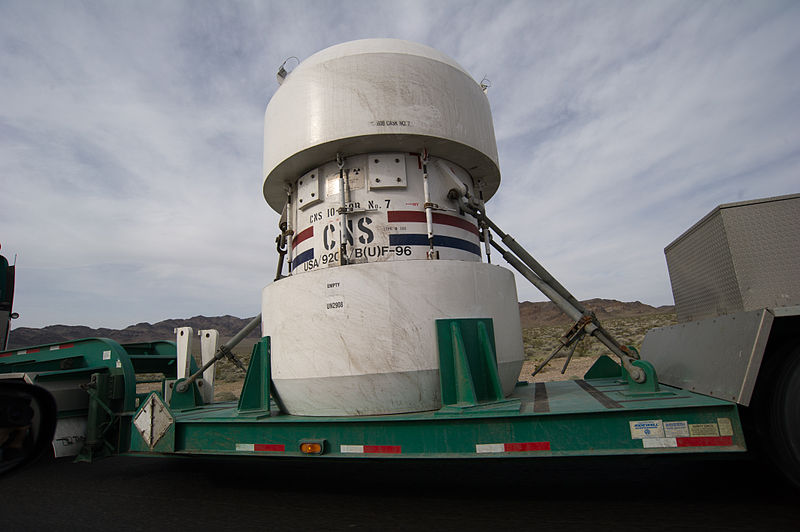
Nuclear waste is a major challenge for the nuclear industry. The most dangerous nuclear waste, which scientists estimate must be cooled and shielded from the outside world for tens of thousands of years, are the spent fuel rods (See: How Nuclear Power Works). They contain a number of radioactive isotopes that result from nuclear fission and have varying half-lives, and therefore varying degrees of danger. Iodine-131, for instance, has a half-life of eight days, meaning every eight days it loses half of its radioactivity and after a short time will no longer pose any danger to living things. Iodine-129 on the other hand has a half-life of 15.7 million years. What to do with this nuclear waste is one of the most difficult problems facing the nuclear industry. Most countries with nuclear programs are looking to put the final waste in deep underground repositories that will be protected in perpetuity; none have yet begun to do so.
The problem poses a unique ethical dilemma: does our need for energy outweigh the multi-generational commitment we are making in storing this potentially hazardous waste? Can we be sure that the tremendous volumes of radioactive material do not fall into the wrong hands or leak into the atmosphere after an earthquake? It is, after all, impossible to know who or what will be living on Earth in 100,000 years; our oldest civilizations are a mere 6,000 years old. We can perhaps, try and explain the threat to them. At least that's the strategy undertaken by the United States. Their Department of Energy had planned (until recently) on burying their 56,000 tons of nuclear waste below Yucca Mountain, Nevada. Around the site they planned on erecting a wall of salt, 48 monoliths with warnings written in English, French, Russian, Arabic, Chinese, Spanish and Navajo, burying thousands of tiny placards around the area, as well as several buried information centers that employed pictograms to scare away any potential future explorers or archaeologists about the dangers that lay within the mountain.
New plants, like the Generation IV plants that are forecast to begin coming online around 2030, will be able to extract energy from a number of radioactive isotopes, and from very diluted quantities of radioactive ores. In fact this means that the nuclear waste created by plants today could be reprocessed and burned in these new reactors. This is why many countries are actually reluctant to bury their nuclear waste in some inaccessible underground vault: that waste may one day be invaluable power plant fuel. This is certainly the case with France, and they appear willing to sit on their nuclear waste until these new plants come online and their waste can be reprocessed again into fuel. The waste created by these new plants will not be nearly as dangerous as that from current, more primitive designs.
Canada's Nuclear Waste
Though Canada has not yet begun planning such elaborate Stonehenge-like precautions for its nuclear waste, the government has been slowly moving forward on the issue of long-term storage. Currently all of the country's nuclear fuel is stored on-site at nuclear plants in concrete-lined holding pools under three metres of water. This is sufficient to block the harmful radiation effects of the waste and after seven to ten years the fuel bundles have cooled enough to be moved to a dry storage facility. Since each plant produces on average about 27 tons of nuclear waste a year, the amount is adding up quickly.
In 2002 the Nuclear Waste Management Organization (NWMO) was created and tasked with deciding what Canada should do with its mounting radioactive stockpiles. The NWMO has recommended a deep geological repository, perhaps in the stable granite formations of the Canadian Shield. There is no timeline to choose a site and the organization recommended taking a gradual approach that builds consensus with all interested parties. The organization is currently designing a process to select a site. Though the rock formations of the Canadian Shield are some of the most ancient and geologically stable in the world, it is impossible to guarantee that any repository site will remain locked away for the thousands of years necessary to let the radioactivity decay away. If the site were to be breached at any point in perhaps as long as 100,000 years, it could prove lethal not only to whoever or whatever is living in the immediate vicinity but for vast distances around. Many opponents of nuclear power question whether this future uncertainty is too high of a price to pay for nuclear power today.
- Intergovernmental Panel on Climate Change. 'PCC Fourth Assessment Report: 4.3.2 Nuclear Energy.' Accessed July 26, 2011. http://www.ipcc.ch/publications_and_data/ar4/wg3/en/ch4s4-3-2.html
- E-126: State of the Art. Enercon. Accessed May 12, 2011. http://www.enercon.de/en-en/66.htm
- M. Jacobson & M. Delucchi. Providing all global energy with wind, water, and solar power, Part I. Elsevier Journal. December 30, 2010. http://www.stanford.edu/group/efmh/jacobson/Articles/I/JDEnPolicyPt1.pdf
- 'Calculate Your Radiation Dose.' US Environmental Protection Agency. Accessed May 12 2011. http://www.epa.gov/radiation/understand/calculate.html
- Mara Hvistendahl. 'Coal Ash Is More Radioactive than Nuclear Waste.' Scientific American. December 13, 2007. http://www.scientificamerican.com/article.cfm?id=coal-ash-is-more-radioactive-than-nuclear-waste
- 'Committee on Medical Aspects of Radiation in the Environment: Fourteenth Report.' COMARE. 2011. http://www.comare.org.uk/press_releases/documents/COMARE14report.pdf
- 'Radiation Protection: Iodine.' US Environmental Protection Agency. Accessed May 12 2011. http://www.epa.gov/rpdweb00/radionuclides/iodine.html
- Douglas Cruickshank. 'How do you design a 'Keep Out!' sign to last 10,000 years?' accessed May 11, 2011. http://dir.salon.com/story/people/feature/2002/05/10/yucca_mountain/index1.html
- 'How Nuclear Fuel Waste is Managed in Canada.' Nuclear Waste Management Organization. May 19, 2011. http://www.nwmo.ca/wastemanagementl
- World Nuclear Association. 'Waste Management.' Updated February 2011. http://www.world-nuclear.org/education/wast.htm
- 'How Nuclear Fuel Waste is Managed in Canada.' Nuclear Waste Management Organization. May 19, 2011. http://www.nwmo.ca/wastemanagementl
Politics of Nuclear Power
The Renaissance on Hold?
The phrase "nuclear renaissance" has entered the public parlance in the past decade or so, a reference to the perceived rebirth of the nuclear industry after the nadir of the post-Chernobyl period. Fighting climate change, meeting soaring future energy demands and finding energy from geopolitically stable regions have all propelled political leaders to advocate for an expansion of nuclear capacity. A 2003 MIT study entitled: The Future of Nuclear Power argued, "We believe the nuclear option should be retained, precisely because it is an important carbon-free source of power." This study helped persuade the U.S. Bush and later Obama Administrations, to openly come out in favour of expanding nuclear power, providing large loan guarantees that underwrote the construction of new plants for the first time since the 1970s.
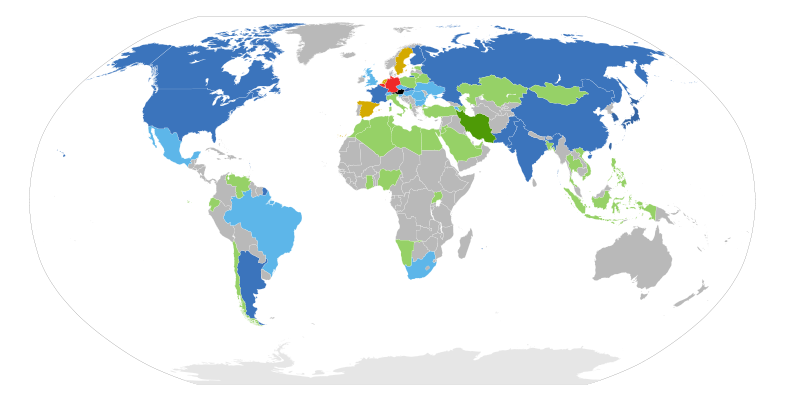
Light Blue: Operating reactors, planning new build
Dark Green: No reactors, building new reactors
Light green: No reactors, new in planning
Yellow: Operating reactors, stable
Red: Operating reactors, decided on phase-out
The study postulated a scenario where the 336 reactors, then in operation, would multiply to anywhere from 1,000 to 1,500 globally by mid-century. This could, with the aid of renewables and energy efficiency improvements, eventually replace the fossil fuel economy. In order to achieve this rapid growth, four problems needed to be seriously addressed in the next decade: economic competitiveness, proliferation, dealing with radioactive waste, and safety.
Seven years on and unfortunately, none of these problems are anywhere near being solved. The study points out that, as of 2003, nuclear power was not economically competitive with fossil-fuel based forms of electricity generation. Without a carbon tax it is unlikely it ever will be. Since then, despite the fact that fossil fuels have become more expensive, nuclear power has not benefitted. Instead it continues to be handicapped by high construction costs and economic uncertainty. A few major economies implemented carbon taxes, such as India, South Korea and the European Union, but the biggest emitters, China and the United States, have not.
As for the proliferation of radioactive materials to terrorists or rogue states, the record is equally bleak. North Korea has detonated two nuclear warheads since 2006, while that country's domestic and diplomatic situation is anything but improving. And despite repeated attempts, the international community is looking increasingly powerless to stop Iran from acquiring a nuclear bomb. Pakistan, with over 100 nuclear warheads, is experiencing alarming political instability. On the plus side there has never yet been a nuclear terrorist attack anywhere in the world.
As for nuclear waste, though many countries are planning to seal it deep underground, these plans have been hit by setbacks and controversies. The most notable example is America's Yucca Mountain. Intended as the nation's nuclear waste repository since 1991, the project was entirely cancelled in 2009 thanks to a sustained opposition campaign from local residents and environmentalists. On the other hand, Finland and Sweden have finally selected sites for their repositories in communities that have volunteered for the site, providing some encouragement to the nuclear industry.
The final issue—nuclear safety—occupies a lot of headlines. The crisis at Fukushima, though not currently anticipated to cause widespread death or illness, has shown that even advanced economies like Japan, with unequaled experience dealing with natural disasters, cannot fully contain the risks inherent to nuclear power. The crisis has caused the International Energy Agency to halve its estimated increase in nuclear capacity by 2030 and lead a number of countries to review their nuclear safety procedures and expansion plans.
For these reasons the plan to use nuclear energy as a central plank of a global climate change strategy appears in doubt.
- Massachusetts Institute of Technology. 'The Future of Nuclear Power: Executive Summary.' Accessed May 19, 2011. http://web.mit.edu/nuclearpower/pdf/nuclearpower-summary.pdf
- Wald, Matthew. 'U.S. Supports New Nuclear Reactors in Georgia.' New York Times, February 16, 2010. Accessed July 28, 2011. http://www.nytimes.com/2010/02/17/business/energy-environment/17nukes.html?hp
- The Future of Nuclear Power: Chapter 1. Massachusetts Institute of Technology. Accessed May 19, 2011 http://web.mit.edu/nuclearpower/pdf/nuclearpower-ch1-3.pdf
- SBS News Australia. 'Factbox: Carbon taxes around the world.' 13 July 2011. Accessed 29 July, 2011. http://www.sbs.com.au/news/article/1492651/at-a-glance-carbon-taxes-around-the-world
- Foreign Policy Magazine. 'Failed States Index 2010.' June 21, 2010. Accessed 29 July 2010. http://www.foreignpolicy.com/articles/2010/06/21/2010_failed_states_index_interactive_map_and_rankings
- World Nuclear Association. 'Waste Management.' Last modified February 2011. http://www.world-nuclear.org/education/wast.htm
- Chandler, Jo. 'Is this the end of the Nuclear Revival?' Sydney Morning Herald. March 19, 2011. Accessed July 29, 2011. http://www.smh.com.au/environment/energy-smart/is-this-the-end-of-the-nuclear-revival-20110318-1c0i9.html
Nuclear Power Around the World
After the first nuclear plant was connected to the civilian electric grid in the Soviet Union in 1964, hundreds of of nuclear power plants have been built and operated around the world, amounting to over 14,570 cumulative reactor years of operation. Construction peaked in the late 1970s and early 1980s and has largely flat-lined since. Few governments have risked stirring up a public outcry by announcing new nuclear power plants since the disaster at Chernobyl. Today nuclear power plants are operated by 31 countries, of which over 80 % of all capacity is in the developed OECD countries.
While nuclear power is important to many major economies, only one relies upon nuclear power for more than half of its electricity needs: France. Following the Arab oil embargo in 1973, the French sought to secure their energy independence by aggressively embracing nuclear power. As a French slogan went at the time: "No coal, no oil, no gas, no choice." Today, France operates 68 nuclear reactors that provide the country with 75% of its electricity. While the United States leads the world with over a hundred reactors, the gargantuan size of the American economy means that they still only produce 20% of America's electricity.
In the next decade, global nuclear power capacity is set to expand due to the economic rise of China and India. These countries are only in the initial stages of developing civilian nuclear energy capabilities and as of July 2011 Canada still produces more megawatts of nuclear power than the two combined. But the two energy-hungry economies are catching up at an astonishing pace. China already has 27 nuclear reactors under construction, and 160 more in various stages of planning according to the World Nuclear Association. India is building 5 and is planning another 58.
- European Nuclear Society. 'Nuclear power plants, world-wide.' Accessed July 28, 2011. http://www.euronuclear.org/info/encyclopedia/n/nuclear-power-plant-world-wide.htm
- 50 Years of Nuclear Energy Factsheet.' International Atomic Energy Association, accessed May 19, 2011. http://www.iaea.org/About/Policy/GC/GC48/Documents/gc48inf-4_ftn3.pdf.
- List of OECD Member countries. Organization for Economic Co-operation and Development, accessed May 19, 2011. http://www.oecd.org/document/1/0,2340,en_2649_201185_1889402_1_1_1_1,00.html
- 'World Nuclear Power Reactors & Uranium Requirements.' World Nuclear Association, last modified April 1, 2011. http://www.world-nuclear.org/info/reactors.html
- 'World Nuclear Power Reactors & Uranium Requirements.' World Nuclear Association, last modified April 1, 2011. http://www.world-nuclear.org/info/reactors.html
- 'World Nuclear Power Reactors & Uranium Requirements.' World Nuclear Association, last modified April 1, 2011. http://www.world-nuclear.org/info/reactors.html
- 'World Nuclear Power Reactors & Uranium Requirements.' World Nuclear Association, last modified April 1, 2011. http://www.world-nuclear.org/info/reactors.html
Nuclear Power in Canada
Ever since the beginning of the nuclear age, Canada has been at the forefront of nuclear power development. The country's first civilian reactor opened in 1971, and today Canada operates 18 of them: 16 in Ontario, and one each in New Brunswick and Quebec. They are all CANDU reactors, (CANada Deuterium Uranium) a Pressurized Water Reactor design that has been exported to a number of countries including South Korea, China, India, Argentina, Romania and Pakistan.
Most of Canada's plants were built in the 1960s and '70s, and will be reaching the end of their service lives in the next decade. A plant's 30 to 40 year service life is determined by the wear and tear many essential parts in the plant will suffer over that time period, which could potentially compromise the safe operating of the plant and the safety of its workers. But instead of decommissioning the aging plants, all three provinces are gradually refurbishing them and extending their life spans. Unfortunately, the refurbishment plans have been problematic, with cost-overruns that the World Nuclear Association admits "…In some cases have made it almost as expensive as new construction."
Plans have been in the works for some time to build two new reactors at the Darlington plant. The four reactors at Darlington currently provide Ontario with 3,512 MegaWatts of power, about 20% of its electricity. These plans were suspended after the only company to make a bid, Canada's flagship nuclear power company AECL, announced they could only build the plants for double the province's allotted budget. This was not good enough for Ontario's government and the construction of new plants is currently on hold. The frequent cost overruns and poor sales in CANDU reactors in the past five years has led the government to auction off part of the crown corporation AECL to a private Montreal-based engineering firm, SNC-Lavalin.
In the West, Alberta is tentatively considering using nuclear fission to help oil sands extraction. There are two broadly similar techniques that could be used, known as cyclic steam stimulation (CSS) and steam-assisted gravity drainage (SAGD). Both essentially require water to be heated, turned into steam and pumped underground. This will heat the bitumen and allow it to flow to the surface where it can be extracted and refined into oil. As natural gas is currently used for this process, using nuclear power to provide the steam might make this in situ extraction cheaper and more carbon friendly in the long term. Ontario-based Bruce Power is considering building a 4,000 MW reactor just outside of Peace River, Alberta, about 130 km over the border from B.C. at either Lac Cardinal or Whitemud.
The Alberta government maintains that though it is not actively encouraging such plans, it will consider applications from private companies. Typically, the massive long-term investments required to build a nuclear power plant require close cooperation and subsidization from government. The Alberta government's low-profile approach might then be a factor in Bruce Power's decision to wait and see how market conditions in the oil sands develop in the years ahead. It is also addressing concerns about any threat of water contamination of the Peace River. At this pace it is unlikely a nuclear power plant in the tar sands could come online before the decade is out.
- 'World Nuclear Power Reactors & Uranium Requirements.' World Nuclear Association, last modified April 1, 2011. http://www.world-nuclear.org/info/reactors.html
- CANDU Owners Group. 'CANDU Reactor FAQs.' Accessed August 22, 2011. http://www.candu.org/candu_reactors.html
- CANDU Owners Group. 'CANDU Reactor FAQs.' Accessed August 22, 2011. http://www.candu.org/candu_reactors.html
- 'Nuclear Power in Canada.' World Nuclear Association, last modified April, 2011. http://www.world-nuclear.org/info/inf49a_Nuclear_Power_in_Canada.html.
- CANDU Owners Group. 'CANDU Reactor FAQs.' Accessed August 22, 2011. http://www.candu.org/candu_reactors.html
- World Nuclear Association. 'Nuclear Power in Canada Appendix 2: Alberta Tar Sands.' Accessed August 22, 2011. http://www.world-nuclear.org/info/inf49a_Alberta_Tar_Sands.html
- Nuclear Power. Government of Alberta: Energy. Retrieved July 26, 2011. http://www.energy.alberta.ca/Electricity/1577.asp
Nuclear Power in British Columbia
British Columbia has never had a nuclear power plant or an uranium mine. Until now, there has not been an outstanding need for this source of energy in the province. BC currently generates 86% of its electricity from hydroelectric power, and the potential exists to generate triple that. Massive long-term investments in electric power are a niche that has already been filled by dams, such as the gigantic W.A.C. Bennett Dam.
In light of this, the B.C. Government was in a position to reiterate its desire to avoid nuclear power in the 2010 Clean Energy Act, which aims to "achieve British Columbia's energy objectives without the use of nuclear power."
Uranium Mining in British Columbia
Canada is the world's second-largest uranium producer behind Kazakhstan. Canada also hosts some of the biggest reserves with close to 500,000 tonnes of uranium recoverable, though it is well behind Australia (1,673,000 tonnes) and Kazakhstan (651,000 tonnes). British Columbia, however, is believed to have comparatively little of the country's uranium deposits, which are mostly concentrated in Saskatchewan and the northern territories. In the past BC's reserves were not concentrated enough to make mining economically worthwhile. This has changed as recent rises in uranium prices, combined with the international impetus for a "nuclear renaissance", is beginning to make B.C.'s marginal uranium deposits look more attractive.
After a geological study in 2008 the Boss Power Corp. applied for the rights to begin an environmental survey for a uranium mine approximately 50 km south-east of Kelowna at a site they called the Blizzard deposit. Three days later on April 21, the government, belatedly realizing uranium mining could actually happen in the province, issued a ban not only on uranium mining, but on exploration for it as well. The ban on uranium mining continues to remain in place, though many other kinds of metals and coal are mined extensively throughout the province.
Boss Power has since argued that the government unlawfully expropriated the land at the Blizzard site, without providing a legal and scientific basis for the moratorium. The company sued the province for compensation and in April 2012 Boss Power received a $30 million settlement from the government out of court, a move that was controversial since it greatly exceeded the provincial government's own estimates of how much money Boss Power could reasonably claim to have lost on the investment.
- Our Facilities B.C. Hydro Website, accessed May 19, 2011. http://www.bchydro.com/about/our_system/generation/our_facilities.html
- Bill 17 – 2010: Clean Energy Act. Part 1, Section 2. Documents of the B.C. Legislature. Accessed May 12, 2011. http://www.leg.bc.ca/39th2nd/1st_read/gov17-1.htm#section2
- World Nuclear Association. Supply of Uranium. Retrieved August 23, 2011. http://www.world-nuclear.org/info/inf75.html
- World Nuclear Association. Uranium in Canada. Retrieved August 23, 2011. http://www.world-nuclear.org/info/inf49.html
- Boss Power Corp. 'Boss Power Provides Update on Progress of Expropriation Lawsuit Against Province of British Columbia.' March 28, 2011. http://www.bosspower.ca/main/?news&19d
- CBC News. 'Uranium mine lawsuit costs B.C. $30M.' October 21, 2011. Accessed May 30, 2012.
Bibliography
To ensure continuity of material, all of the external web pages referenced here were cached in May 2012.
Readers are recommended to explore the current links for any changes.
B.C. Hydro. 'Our Facilities.' Accessed May 19, 2012.
B.C. Legislature. 'Bill 17 – 2010: Clean Energy Act. Part 1, Section 2.' Documents of the B.C. Legislature. 2010. Accessed May 12, 2011.
Blue Ribbon Commission on America's Nuclear Future. 'Draft Report to the Secretary of Energy.' July 29, 2011. Accessed May 3, 2012.
Boss Power Corp. 'Boss Power Provides Update on Progress of Expropriation Lawsuit Against Province of British Columbia.' March 28, 2011. Accessed May 3, 2012.
CANDU Owners Group. 'CANDU Reactor FAQs.' Last modified 2011. Accessed May 3, 2012.
Chandler, Jo. 'Is This the end of the nuclear revival?' Sydney Morning Herald, March 19, 2011. Accessed May 3, 2012.
COMARE. 'Committee on Medical Aspects of Radiation in the Environment: Fourteenth Report.' 2011. Accessed May 3, 2012.
Cruickshank, Douglas. 'How do you design a 'Keep Out!' sign to last 10,000 years?' accessed May 3, 2012.
Enercon. E-126: State of the Art. Accessed May 12, 2011.
European Nuclear Society. 'Nuclear power plants, world-wide.' Accessed May 3, 2012.
Fetter, Steve. How long will the world's uranium supplies last?' Scientific American. January 26, 2009. Accessed May 3, 2012.
Foreign Policy Magazine. 'Failed States Index 2010.'June 21, 2010. Accessed 29 July 2010.
Gnansounou, E. and Bedniaguine, D. 'Potential Role of Fusion Power Generation in a Very Long Term Electricity Supply Perspective: Case of Western Europe.' Swiss Federal Institute of Technology. Accessed May 3, 2012.
Hvistendahl, Mara. 'Coal Ash Is More Radioactive than Nuclear Waste.' Scientific American. December 13, 2007.
Government of Alberta: Energy. 'Nuclear Power.' Accessed May 3, 2012.
IPCC Fourth Assessment Report. Climate Change 2007: Working Group III: Mitigation of Climate Change, 4.3.2 Nuclear energy. Accessed May 3, 2012.
Jacobson, M. & Delucchi, M. 'Providing all global energy with wind, water, and solar power, Part I.' Elsevier Journal. December 30, 2010.
International Atomic Energy Association. '50 Years of Nuclear Energy Factsheet.' Accessed May 3, 2012.
Johnson, Keith. 'It's the Economics, Stupid: Nuclear Power's Bogeyman.' Wall Street Journal. May 12, 2008.
'Nuclear Phaseout Is an 'Historic Moment'' Der Spiegel, May 30, 2011, accessed May 3, 2012.
Massachusetts Institute of Technology. 'The Future of Nuclear Power: Executive Summary.' Accessed May 19, 2011.
Nuclear Waste Management Organization. 'How Nuclear Fuel Waste is Managed in Canada.'May 19, 2011.
Ontario Power Generation. 'Nuclear Power in Ontario.' Accessed May 3, 2011.
Organization for Economic Co-operation and Development. List of OECD Member countries. Accessed May 3, 2012.
Polson, J., Chipman, K & Chediak, M. Nuclear Renaissance Threatened as Japan's Reactor Struggles. Bloomberg News. March 13, 2011. Accessed May 3, 2012.
SBS News Australia. 'Factbox: Carbon taxes around the world.' 13 July 2011. Accessed May 3, 2012. http://www.sbs.com.au/news/article/1492651/at-a-glance-carbon-taxes-around-the-world
Stewart, Bob. 'Liberal energy plan includes costly nuclear future for price hike weary consumers.' Kenora Daily Miner and News. January 2011.
US Environmental Protection Agency. 'Radiation Protection: Iodine.' Accessed May 3, 2012.
US Environmental Protection Agency. 'Calculate Your Radiation Dose.' 2012. Accessed May 3, 2012.
Wald, Matthew. 'U.S. Supports New Nuclear Reactors in Georgia.' New York Times, February 16, 2010. Accessed May 3, 2012.
World Nuclear Association. 'Waste Management. 'Updated February 2011. Accessed May 3, 2012.
World Nuclear Association. 'Safety of Nuclear Reactors. 'Last modified 26 July 2011. Accessed 28 July 2011,
World Nuclear Association. 'Supply of Uranium. Accessed May 3, 2012.
World Nuclear Association. 'Nuclear Power in Canada Appendix 2: Alberta Tar Sands.' Accessed May 3, 2012.
World Nuclear Association. 'Nuclear Power in Canada,' Last modified April, 2011. Accessed May 3, 2012.
World Nuclear Association. 'Uranium Mining.' Accessed May 3, 2012.
World Nuclear Association. 'Economics of Nuclear Power' Last modified March 9, 2011. Accessed May 3, 2012.
World Nuclear Association. Nuclear Renaissance. Accessed May 3, 2012.

